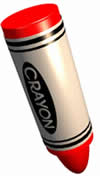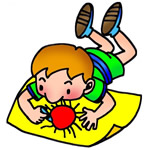
Grades 9-12

Don't have an account yet? Sign up for free
Don't have an account yet? Sign up for free


In this lesson you will learn about the things that are used to make crayons. Your teacher may ask you tothink about the things that are used to make crayons. Sometimes when we see things every day we forget that “everything comes from something,” The “something” that every thing comes from is called resources. You will then identify and classify the natural, capital, and human resources used in the production of crayons.
Click here to complete the activity. Click on the pictures and drag them over to the box that tells what kind of resource each one is.
You have read a book titled How a Crayon Is Made. Think about the book: what did it tell you about the resources (natural, human, and captial) needed in the process of making crayons? Take a minute to make a list of the different resources that you remember that are needed to make crayons. (For example a factory would be a capital resource; a factory worker would be a human resource.) After creating your list of resources, watch this video on how crayons are made.
When we want something, we usually can go to the store and buy it, or sometimes someone gives us what we want. But where do those things come from in the first place? Everything comes from something, and the “something” that everything comes from is called resources.
You have 30 seconds to go around the room and find and identify examples of resources- natural resources, capital resources, and human resources. All the students then will share their findings. If you can do this quietly, we may also be able to do the search for resources in other parts of the building to see if we can find anything different.
Click here to complete the worksheet. Remember what each resource is. Draw a line from the pictures to one of the three boxes to show whether each resource is a natural, capital or human resource.

1. If your teacher says it is all right, you can make your own crayons by recycling your old crayons. Bring your old crayons to school.
Your CAPITAL REOURCES in this case will be old crayons, something to melt the crayons, and molds provided by your teacher.
You and your teacher will provide the HUMAN RESOURCE by peeling the crayons, breaking them into small pieces, sorting them by color, and placing the pieces into molds or cupcake holders. If it is not hot enough for the sun to do the melting, your teacher will melt the crayons with a toaster oven, or a microwave. REMEMBER, THIS IS NOT AN ACTIVITY FOR YOU TO DO BY YOURSELVES. WAX IS FLAMMABLE.
 If it is hot outside, you can simply set the crayons in their molds out in the sun and let the sun be your NATURAL RESOURCE.
If it is hot outside, you can simply set the crayons in their molds out in the sun and let the sun be your NATURAL RESOURCE.
People who make a product are called producers. People who use or buy that product are called consumers.
If your crayons turn out nicely and your teacher helps you to set up a Producers and Consumers activity.You might package sets of crayons and sell them to the other students in your school. You could use the money from these sales for a worthy cause or a class goal. You might also consider packaging the crayons to send to needy children who might not otherwise have crayons.
2. Record interesting facts that you learned about crayons along the way: How old are crayons? How many different colors of crayon wrappers are there? What are the two favorite colors around the world?
3. Graph the favorite crayon colors of students in the class, using the colors from the 8 box. Which color won? Did any colors not get a vote?
4. Color a picture with some of your homemade crayons!!!

Grades 9-12

Grades 6-8, 9-12

Grades 3-5, 6-8, 9-12

Grades K-2
